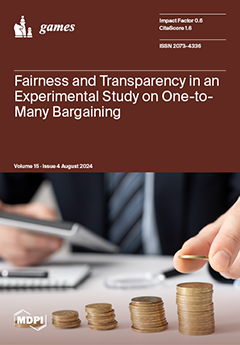The literature on
strategic ambiguity in classical games provides generalized notions of equilibrium in which each player best responds to
ambiguous or
imprecise beliefs about his opponents’ strategic choices. In a recent paper, strategic ambiguity has been extended to
psychological games, by
[...] Read more.
The literature on
strategic ambiguity in classical games provides generalized notions of equilibrium in which each player best responds to
ambiguous or
imprecise beliefs about his opponents’ strategic choices. In a recent paper, strategic ambiguity has been extended to
psychological games, by taking into account ambiguous
hierarchies of beliefs and max–min preferences. Given that this kind of preference seems too restrictive as a general method to evaluate decisions, in this paper we extend the analysis by taking into account
-max–min preferences in which decisions are evaluated by a convex combination of the worst-case (with weight
) and the best-case (with weight
) scenarios. We define the
-max–min psychological Nash equilibrium; an illustrative example shows that the set of equilibria is affected by the parameter
and the larger the ambiguity, the greater the effect. We also provide a result of stability of the equilibria with respect to perturbations that involve the attitudes toward ambiguity, the structure of ambiguity, and the payoff functions: converging sequences of equilibria of perturbed games converge to equilibria of the unperturbed game as the perturbation vanishes. Surprisingly, a final example shows that the existence of equilibria is not guaranteed for every value of
.
Full article





